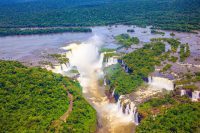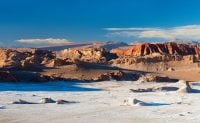Argentina has 35 national parks with a huge range of climates, terrains, and experiences. Here are just a few of the most notable examples, but there are many more. Want to know more about the National parks in Argentina?
Los Glaciares National Park and Perito Moreno
Los Glaciares is the largest National Park in Argentina. And very unique. It’s home to famed glacier and one of the biggest attractions in the country, the Perito Moreno glacier – which has its own national park.
There are 47 glaciers in the park, born from the ice cap in the southern Andes. But Perito Moreno is the easiest to reach and the most visited glacier in the park.
What’s special about Perito Moreno National Park?
- Perito Moreno is a UNESCO World Heritage site.
- It’s one of the biggest draws to Argentina.
- It’s the only glacier in the world that continues to grow.
- It’s one of the few glaciers you can ice hike on.
- It’s the only glacier in the park that can be reached easily after a short hike.
- It’s the sister park of Torres del Paine National Park in Chile.
Other sites in the park
The park is also home to the Spegazzini Glacier and Upsala Glacier, but you need to take a boat trip to visit them.
The famous Monte Fitz Roy (Mount Fitz Roy) is also located here. Fitz Roy is a spectacular jagged landscape and a major draw for hard-core hikers, with a summit of 3,405 m.
Iguazu National Park
Argentina – and Patagonia – are full of contrasts. Where Los Glaciares National Park has a cold enough climate for glaciers, Iguazu National Park is a tropical paradise, the largest of the many waterfalls in Argentina and one of the biggest series of waterfalls in the world, and one of the most spectacular places on Earth.
There are exceptional hiking trails and abundant and unique wildlife in this park. These include 400 species of birds, tapirs, giant anteaters, howler monkeys, coatimundis, caimans and several wildcat species including jaguars. Not to mention 80 tree species and some 2000 plant species.
What’s special about Iguazu?
- The falls extend almost 3 kilometers in a series of cascades 80 meters high.
- Forms the border between Argentina and Brazil with its magnificent horse-shoe shaped cataract aptly named the Devil’s Throat.
- The continuous spray from the falls produces its own micro-climate
Tierra Del Fuego National Park
A spectacular wash of fjords, jagged mountains, bays and peaceful valleys, the Tierra Del Fuego National Park is the only location in Argentina where the Andes mountains and the Patagonian forests meet the sea.
There are many hiking trails in the park with a range of difficulty levels. Trek to Lapataia Bay for an amazing vantage point overlooking the Beagle Channel.
You can also explore the park by train on the Austral Fueguino Railway or the ‘End of the World Train’. It runs for 7 kilometers along the river and through the sub-arctic forest stopping at several places and takes you to the post office at the End of the World – the southernmost postal service on Earth.
Wildlife is abundant at the end of the world. Bird watchers flock there to witness some 90 avian species including black-browed albatrosses, Andean Condors, Magellanic woodpeckers and Austral thrushes. Marine wildlife abounds too including sea lions and penguins.
What’s special about Tierra del Fuego National Park?
- It’s the only national park in Argentina that has a shoreline.
- It has the southernmost post office on Earth.
- Ferdinand Magellan named it Land of Fire after seeing lots of small fires lit by the local Ona Indians.
More about the national parks in Argentina
Here are a few other notable examples, but there are many more.
Nahuel Huapi National Park
Located on the board with Chile, this is the second-largest national park in Argentina and the country’s first national park, known for its glorious lakes with mountain backdrops. Diverse as the southern cone, expect to find waterfalls, forests, and a huge range of wildlife including guanacos, river otters, and cougars.
Alcerce National Park
Alcerce National Park is named for its special forests of Alcerce trees, very large trees that resemble Sequoias and belong to the Cypress family. The park also features a stunning range of alpine meadows, beautiful blue lakes (where you can take boats), and glacial cirques where glaciers have carved out crater-like shapes in mountains.
The national parks in Argentina are a marvel that you will not stop contemplating.
No comments yet
There are no comments on this post yet.




Leave a comment